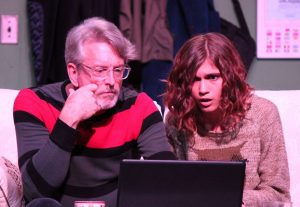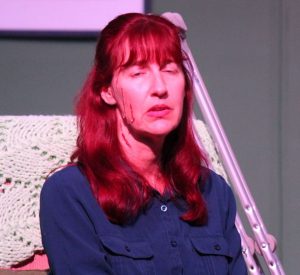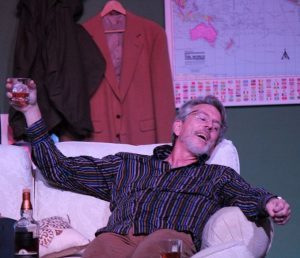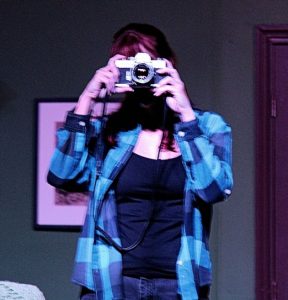‘Time Stands Still’ beautifully acted, well staged and immensely thought-provoking
 On stage for four more performances at New Phoenix Theatre is Donald Margulies’ Time Stands Still. Directed by Lois Kuehne, it stars Stacy Stauffer as war photographer Sarah Goodwin, Blake Dunkle as her love interest, James Dodd, Ken Johnson as their editor, Richard Ehrlich, and Eren Sisk as Ehrlich’s young lover and the voice of social conscience in the play.
On stage for four more performances at New Phoenix Theatre is Donald Margulies’ Time Stands Still. Directed by Lois Kuehne, it stars Stacy Stauffer as war photographer Sarah Goodwin, Blake Dunkle as her love interest, James Dodd, Ken Johnson as their editor, Richard Ehrlich, and Eren Sisk as Ehrlich’s young lover and the voice of social conscience in the play.
This is Stauffer’s most ambitious role to date, and she gives a master class in expressing inner turmoil. There are scenes when that conflict manifests itself verbally, but for most of the show, Stauffer is called upon to reveal the depths of her psychological damage  through an interrelated medley of facial expressions, body language and passive-aggressive cues. To complicate matters, Sarah Goodwin is not the most sympathetic character who’s ever graced a stage. She’s egocentric, entitled, condescending and less than empathetic. [When Mandy divulges that she’s an event planner, Sarah smugly replies “I guess you can say I’m into events too – wars, famines, genocides. . .”] This notwithstanding, Stauffer renders Goodwin
through an interrelated medley of facial expressions, body language and passive-aggressive cues. To complicate matters, Sarah Goodwin is not the most sympathetic character who’s ever graced a stage. She’s egocentric, entitled, condescending and less than empathetic. [When Mandy divulges that she’s an event planner, Sarah smugly replies “I guess you can say I’m into events too – wars, famines, genocides. . .”] This notwithstanding, Stauffer renders Goodwin  relatable enough that the audience develops a rooting interest in her welfare and the outcome of the dilemmas she confronts over the course of the play.
relatable enough that the audience develops a rooting interest in her welfare and the outcome of the dilemmas she confronts over the course of the play.
So what exactly is Sarah Goodwin’s problem? Where to start? She’s a rich kid with a nice, tidy trust fund that enables her to do pretty much anything she wants. Her partner, James, accuses her of feeling guilty that she’s so comfortable, but the extent  to which that may be part of her psyche is never developed. But what does emerge is Sarah’s rejection of conventional life. She’s not a fan of marriage, finds the idea of having children abhorrent, and cannot contemplate a life without risk. Not even the scars and other injuries she received in an IED explosion that killed her fixer can induce her to envision a normal, pedestrian life. But Margulies’ script leaves it open to
to which that may be part of her psyche is never developed. But what does emerge is Sarah’s rejection of conventional life. She’s not a fan of marriage, finds the idea of having children abhorrent, and cannot contemplate a life without risk. Not even the scars and other injuries she received in an IED explosion that killed her fixer can induce her to envision a normal, pedestrian life. But Margulies’ script leaves it open to  interpretation whether Sarah Goodwin is heroically committed to making a difference in the world through her photo-journalism or is just an adrenaline junkie with a latent death wish. [If this ambiguity isn’t written into the character, then kudos to Director Lois Kuehne and Stacy Stauffer for interjecting an added layer of depth to Sarah Goodwin’s mental make-up.]
interpretation whether Sarah Goodwin is heroically committed to making a difference in the world through her photo-journalism or is just an adrenaline junkie with a latent death wish. [If this ambiguity isn’t written into the character, then kudos to Director Lois Kuehne and Stacy Stauffer for interjecting an added layer of depth to Sarah Goodwin’s mental make-up.]
 Blake Dunkle’s character, James Dodd, serves as counterpoint to Sarah. Speaking of guilt, Dodd knows of what he speaks. He’s guilty that he left Sarah behind after narrowly surviving an unrelated incident. And he’s guilty over having lost his nerve to return to the fray. He tries to compensate by being overly solicitous, almost fawning, traits that wear on Sarah and the audience
Blake Dunkle’s character, James Dodd, serves as counterpoint to Sarah. Speaking of guilt, Dodd knows of what he speaks. He’s guilty that he left Sarah behind after narrowly surviving an unrelated incident. And he’s guilty over having lost his nerve to return to the fray. He tries to compensate by being overly solicitous, almost fawning, traits that wear on Sarah and the audience  as the play progresses. But Dodd is no milk toast, and Dunkle has a terrific scene in which he gets to explore emotions ranging from anger and rage to confusion and abject dejection.
as the play progresses. But Dodd is no milk toast, and Dunkle has a terrific scene in which he gets to explore emotions ranging from anger and rage to confusion and abject dejection.
Ken Johnson is enjoyable in the role of Sarah and James’ editor. He too is conflicted. As a friend, he wants what’s best for Sarah and James. But as their editor, he’d like them to get back in the game. But it’s his attempts to explain and justify his relationship with his girlfriend to Sarah and James that injects some much-needed humor into the play.
 Eren Sisk distinguishes herself as new-kid-on-the-block Mandy Bloom. In the play, Sarah dismisses Mandy as a lightweight, but there’s nothing lightweight about the way Sisk plays the part (which has been portrayed elsewhere by the likes of Alicia Silverstone and Golden Globe and Emmy-nominated Christina Ricci). Bloom is the epitome of wide-eyed naivety and Sisk mines this aspect of her character like a Klondike prospector or a (ahem) San Francisco 49er. She absolutely, positively
Eren Sisk distinguishes herself as new-kid-on-the-block Mandy Bloom. In the play, Sarah dismisses Mandy as a lightweight, but there’s nothing lightweight about the way Sisk plays the part (which has been portrayed elsewhere by the likes of Alicia Silverstone and Golden Globe and Emmy-nominated Christina Ricci). Bloom is the epitome of wide-eyed naivety and Sisk mines this aspect of her character like a Klondike prospector or a (ahem) San Francisco 49er. She absolutely, positively  nails the scene in which her character is looking at images that Sarah took in Iraq of people killed and maimed in bombings, terrorist attacks and similar war-related incidents.
nails the scene in which her character is looking at images that Sarah took in Iraq of people killed and maimed in bombings, terrorist attacks and similar war-related incidents.
For all the fun and frivolity implicit in Bloom’s character and circumstances, Mandy plays an intricate role in giving voice to the thematic content of Time Stands Still. Clearly Gen-X, Bloom unexpectedly embraces traditional norms such as the desire for marriage,  children and family over career. But Bloom also challenges the morality of exposing the pain and indignity of the dead and dying in monotone and color – while passively standing on the sidelines instead of giving aid and comfort to the subjects in their images.
children and family over career. But Bloom also challenges the morality of exposing the pain and indignity of the dead and dying in monotone and color – while passively standing on the sidelines instead of giving aid and comfort to the subjects in their images.
The ethics and morality of photographing unsuspecting people is not the exclusive domain of photo-journalists and war correspondents. It is encountered by  everyone and anyone who engages in street photography.
everyone and anyone who engages in street photography.
Pioneered by Henri Cartier-Bresson, street photography features unmediated encounters that occur within the public domain. While Cartier-Bresson’s protégés justify their intrusions into their subjects’ privacy as attempts to illuminate facets of society that aren’t readily obvious to the naked eye, many were motivated by far less lofty aspirations, such  as merely capturing that raw, unguarded moment in time. But since its earliest days, there has been a discord between the street photographer and their subjects, a dissonance which raises questions of ethics and morality that arise whenever anyone with a cell phone employs their device to snap a picture of a stranger they happen upon in any public venue.
as merely capturing that raw, unguarded moment in time. But since its earliest days, there has been a discord between the street photographer and their subjects, a dissonance which raises questions of ethics and morality that arise whenever anyone with a cell phone employs their device to snap a picture of a stranger they happen upon in any public venue.
Without giving away  too much, be sure to focus on the scene in which Mandy breaks down in tears as she recounts her reaction to watching an elephant calf become separated from her mother while the National Geographic crew does nothing to reunite the two and prevent the calf from becoming prey. It’s an evocative explication of the bona fides of the photographer’s edict to never become part of the story, and Sisk delivers the message in a powerfully memorable way.
too much, be sure to focus on the scene in which Mandy breaks down in tears as she recounts her reaction to watching an elephant calf become separated from her mother while the National Geographic crew does nothing to reunite the two and prevent the calf from becoming prey. It’s an evocative explication of the bona fides of the photographer’s edict to never become part of the story, and Sisk delivers the message in a powerfully memorable way.
But Sisk does  more than merely acquit herself well in these isolated, yet demanding, scenes. She walks a tightrope with the aplomb of Maria Spelterini between her character’s youthful innocence and inexperience and her seemingly incongruous demand to be taken seriously. That she’s able to navigate between these polarities so seamlessly shows that Sisk is making tremendous progress in becoming a penultimate character actor.
more than merely acquit herself well in these isolated, yet demanding, scenes. She walks a tightrope with the aplomb of Maria Spelterini between her character’s youthful innocence and inexperience and her seemingly incongruous demand to be taken seriously. That she’s able to navigate between these polarities so seamlessly shows that Sisk is making tremendous progress in becoming a penultimate character actor.
New Phoenix’s version of Time Stands Still is beautifully acted,  finely staged and immensely thought provoking. It’s not lighthearted fare for those looking for an escape from the endless drone of the impeachment trial. Replete with complex characters, delightfully realistic dialogue and weighty philosophical themes, Time Stands Still provides an intellectually stimulating two hours which, in the playwright’s own words “capture[s] a sense of the way we live now,
finely staged and immensely thought provoking. It’s not lighthearted fare for those looking for an escape from the endless drone of the impeachment trial. Replete with complex characters, delightfully realistic dialogue and weighty philosophical themes, Time Stands Still provides an intellectually stimulating two hours which, in the playwright’s own words “capture[s] a sense of the way we live now,  [dramatizing] the things that thinking, feeling, moral people are thinking about and struggle[ing] with.”
[dramatizing] the things that thinking, feeling, moral people are thinking about and struggle[ing] with.”
Time Stands Still wraps up with four final performances beginning tonight and concluding with Sunday’s 3:00 p.m matinee.
January 30, 2020.
RELATED POSTS.
 New Phoenix’s ‘Time Stands Still’ features complex characters, crackling wit
New Phoenix’s ‘Time Stands Still’ features complex characters, crackling wit- Lois Kuehne returns to Fort Myers to direct ‘Time Stands Still’ for New Phoenix
- Spotlight on ‘Time Stands Still’ actor Stacy Stauffer
- Spotlight on ‘Time Stands Still’ actor Kenneth Bradley Johnson
- Spotlight on ‘Time Stands Still’ actor Eren Sisk
- ‘Time Stands Still’ play dates, times and ticket information














 Tom Hall is both an amateur artist and aspiring novelist who writes art quest thrillers. He is in the final stages of completing his debut novel titled "Art Detective," a story that fictionalizes the discovery of the fabled billion-dollar Impressionist collection of Parisian art dealer Josse Bernheim-Jeune, thought by many to have perished during World War II when the collection's hiding place, Castle de Rastignac in southern France, was destroyed by the Wehrmacht in reprisal for attacks made by members of the Resistance operating in the area. A former tax attorney, Tom holds a bachelor's degree as well as both a juris doctorate and masters of laws in taxation from the University of Florida. Tom lives in Estero, Florida with his fiancee, Connie, and their four cats.
Tom Hall is both an amateur artist and aspiring novelist who writes art quest thrillers. He is in the final stages of completing his debut novel titled "Art Detective," a story that fictionalizes the discovery of the fabled billion-dollar Impressionist collection of Parisian art dealer Josse Bernheim-Jeune, thought by many to have perished during World War II when the collection's hiding place, Castle de Rastignac in southern France, was destroyed by the Wehrmacht in reprisal for attacks made by members of the Resistance operating in the area. A former tax attorney, Tom holds a bachelor's degree as well as both a juris doctorate and masters of laws in taxation from the University of Florida. Tom lives in Estero, Florida with his fiancee, Connie, and their four cats.